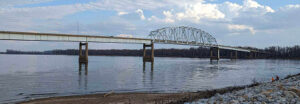
Before constructing roads, bridges, or buildings, governments need to know how those structures fare in a storm. For example, a road is no good if it floods every time there’s heavy rainfall.
Knowing how hazards affect an area is a core responsibility of any community. And with stronger storms and more frequent flooding, local leaders need updated and accurate data to protect people and property from increasing dangers.
Fortunately with flood models, communities can make smart, informed decisions about how to design and build infrastructure to ensure public safety. These models can be used to design water infrastructure, study natural systems, regulate areas, or map floodplains. This is especially important as communities apply for and receive funds from the bipartisan infrastructure law.
To better understand what goes into these models, we talked to Liz Perez, president and founder of AFC member Collective Water Resources, LLC. Perez also advises the American Flood Coalition on matters related to flood data and risk assessments.
This interview has been edited for length and clarity.
American Flood Coalition: What is water resources engineering?
Liz Perez: Water resources engineering is related to any sort of practical interaction with the science of water as a resource — a resource to human beings, to the environment, to natural systems. And that encompasses all different aspects of engineering, from the engineers that are doing scientific work — like the academics or engineers doing analyses and studies — all the way to the very practical engineer that is building a levee or some other very visible water resources project.
AFC: Does Collective Water Resources have a focus?
LP: At Collective, we focus on the analyses and modeling as it pertains to a lot of different aspects of water. There are two big water problems that are very visible to human beings: one is water supply, or when you don’t have water to drink; the other one is flooding. And for most people in the United States, flooding is the dominant issue they’re aware of within the water resources realm.
AFC: What value does Collective Water Resources add when working with a client?
LP: We’re the analytical arm of our clients. Most clients aren’t going to get trained on 10 different hydraulic models — they don’t have the in-house resources to do that themselves. And we focus on government clients and the needs of government. We are the ones that remain well versed in models, as well as tools like GIS [Geographic Information Systems, or digital maps].
Our job is to crunch the numbers and gather the information and data and distill that in a way that’s helpful to governments as they make decisions. We do not make decisions ourselves; instead, we provide the data and potential solutions, and then it’s up to the government to determine the path.
AFC: How do you articulate the value of data-driven decision making?
LP: We’re dealing with solutions that are usually very expensive, and models provide a tool based on best available science and data that can help us make decisions. Without data, we’re shooting in the dark.
We’re investing billions of dollars in these projects, so why wouldn’t we use computers, which let us easily and relatively inexpensively come up with a number of alternatives and then make decisions based on that? I don’t think it’s perfect, but it’s the best we have, and I would almost always rest on data and numbers and a good engineer versus shooting in the dark.
AFC: Can you talk about some of the main factors you consider when modeling a watershed?
LP: One of the most important factors is to work with an engineer that’s licensed in that area and who understands the local hydrology. Any engineer will tell you, you have to understand site conditions. And then for modeling, topography is a really important base layer. Bathymetry [the measurement of the underwater features of rivers, lakes, and oceans] is also helpful for any sort of ground surface, below-water bodies.
And then just good data: It takes years to create really good datasets for modeling, especially given climate change, when we’re looking over long periods and we’re trying to project into the future. Modeling is part of a cycle — it begins when you start collecting data, but there is also the long-term usage and maintenance of the model to consider. Smart governments reuse their models and use them across multiple initiatives.
AFC: How did you get into water resources engineering?
LP: Growing up in Denver, I came to love the environment. Every year we would go camping. I spent a summer in Yellowstone doing things in the wild, staring for hours at spiders. I always liked the natural world and felt drawn to it. I’m an introvert too, and I like to joke that my favorite clients are animals. Feeling like I’m working for the natural world is a really good feeling.
AFC: Water resources engineering is historically a male-dominated field. How have you navigated that?
LP: Early in my career I was oftentimes the only woman in a meeting. And I got used to it. But particularly in the field of climate change, there are a lot of really amazing women leading the charge. And within water resources, there are a lot of amazing women. They’re making some of the most significant contributions and being leaders, and the mood has really changed as a profession.
AFC: Is there anything else you’d like to add?
LP: There are amazing water resources engineers that do really practical things. There are engineers that will work on the same dam for 10 years, go out to the project site and make sure that it’s safe. It’s also a profession that serves human beings to a significant degree. And I personally believe that if you serve the environment, you’re serving humans.
—
This post was authored by Brandon Pytel, Communications Associate, American Flood Coalition.






